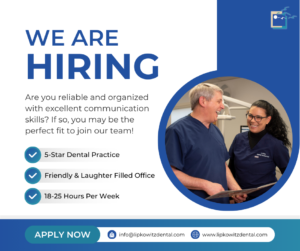We’re sitting down with Dr. Rob to discuss the dental report card given to patients at Lipkowitz Dental Associates.
How do you track progress with these report cards?
The dental report card is a way of communicating a patient’s health to the patient in a way that they can digest the information and use it to improve their own health at home.
We track how much bleeding is in their mouth and the periodontal probing pockets around their mouth and then they get a score. That score tells them whether they’re in a healthy category, whether they’re in a mildly at-risk category, or whether they’re in a high-risk category in terms of how they’re maintaining their mouth and the likelihood they may have problems in the future based on where they are in their report card.
How has the report card improved your communication with patients?
I read a study several years ago and it said what a dentist says to you when you go in for your cleaning has more to do with their mood for the day than it is actually what’s going on in your mouth.
So, you come in for a cleaning and the dentist or the hygienist says, “Oh, you don’t, don’t look quite as good this time as you looked last time”. Well, I can tell you honestly, you have no idea – with a six-month visit, to be able to remember that information is impossible. They’re looking at you and if they see bleeding and a few pockets, maybe that’s better than last time, but today it doesn’t feel better to them.
The report card gives us actual data. We’re looking at the actual number of bleeding areas and the number of pockets that are deeper than normal or if the pockets are all within the normal range and from visit to visit, we’re giving you accurate objective data rather than subjective data, which can change.
Have you experienced any success stories with the dental report card in your practice?
I have to say that this is one of the things that has transformed my practice. I was always so impressed with the hygiene programs and other offices that I’ve worked in because as hard as the hygienists would work to get people healthy and keep them healthy, changing people’s behavior is difficult. But, when people understand that what they do at home actually does give them control and an impact on their health, then they really start to do what’s necessary.
So, if you come in one day and you have more bleeding than is ideal for your future dental health and you go home and you decide to floss every night. You come back a few months later and we check those pockets and bleeding. You’re healthier because you floss, and you can see the impact that’s made. Then, maybe you get stressed out and you stop flossing again for a while and you come back and you see, “Oh, you know what, I stopped flossing my scores went down”. Once patients associate what they do at home with the improvement or the lack of improvement in what’s going on in their mouths, they really start to do what’s necessary to stay healthy.
Adults want to be healthy. We do what is necessary to be as healthy as possible if we think we have control over it. I just love the fact that patients come in and they are so much healthier than they were between cleanings. We want to see patients coming in in a healthy range from cleaning to cleaning, not dropping down into a disease, and then coming back and becoming healthy again. There comes a point in a person’s life where if their immune system is not functioning properly, then they may not be able to get back to healthy again, or at least not without some severe measures. So, staying healthy is always much better than getting healthy again.
Patients love the report cards! They hang them on their fridge, husbands and wives compete with each other, and we’ve even started adding gold stars to them!
If you need a dental report card to track your oral health progress, visit www.lipkowitzdental.com and book your appointment today.





